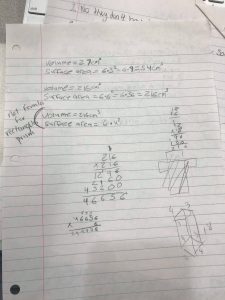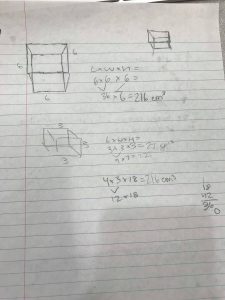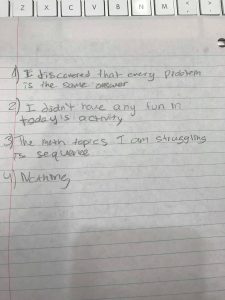Context
Our lesson plan was to help students understand the relationship between congruent shapes; their volumes, surface areas, and see if they can answer our daily question. The question of the day was “Do 2 shapes with the same volume need to have the same surface area?” and so what we decided to do was use 2 congruent cubes and a cuboid that had the same volume as the bigger cube. Since our classroom, more like an afterschool program, is made up of 8th graders, we wanted to make this activity a bit more interactive. Our interactive part was for students to look at the cubes and using them to help them solve the problem.
Our group was a bit confused about what congruency meant and some had a bit of trouble when it came to using the formulas. In our first observation, we really didn’t get a chance to see or ask what the students knew already, other than seeing a homework assignment. Keeping in mind that the students have been in class for 7 hours, we decided to go with geometry to have a more interactive activity for them.
Objectives
Our key learning objectives within our lesson were to have students
- Investigate 3D figures in relation to each other
- Analytically compare 3D figures in relation to their volume or surface area
- Think about applications of vlume of 3D shapes
- Understand the relationship between 2D shapes and surface area
The reason we had these objectives were to satistfy the Math Core Standard of Geometry for 8th grades.
Activities (outline)
The activities that we had were introduction, group work, volunteering, and reflection. Each having a perk to helping the students learn, some worked better in group settings while other worked best individual, and others felt comfortable with the whole class.
Introduction
We introduced physical 3D shapes. With these shapes we let the students play with them and pass them around so that they can understand the difference of it not being a 2D shape.
Group Work
After the shapes were passed out we drew the 2 congruent shapes with their measurements and asked the students to find out the volume and surface area of the shapes. Some students worked alone and other worked with their mentor (Trinity Students).
Measurements for small cube: 3″cm
Measurements for big cube: 6″cm
These pictures are the students work



Then, we had another shape introduced, cuboid, and had them find the surface area for it.
Volunteering
As we walked around we noticed when students were wrapping up their ideas or done with the problem, was when we would ask students if they were willing to come up or explain their findings for the questions.
Reflection
At the end of the day, we made the students write up a small reflection answering a couple of questions that me and Rafael Villa (my partner) had, to either improve or know more aboutthe kids.
- What did you discover today? Which would let us see if they understood what the whole day was about. They would be required the answer the question of the day and from there we would see if we were able to get to the kids through our lesson.
- Did you have during today’s activities? We asked this question to see whether we adapted adequatly to the settting. Again, our class is an afterschool program, which required us to be more creative with the students. So, if the kids didn’t have fun, then that would indicate that we were not facilitating the wokshop the best way. We want the students to enjoy the material and to learn math in a fun a creative way!
- What math topics would you want us to go over next time? This was more for a guidance to what our next workshop would revolve around. We do not have specific standards that we have to hit, but we want to help the students understand and love math while we are there.
- What activities would you like to do in the future?
The following images are pictures of the responses of the students.




Assessment
I was the first facilitator within our workshop and that way me and Rafael decided to facilitate was by jumping around, while the other presented, and having them write the reflection journal at the end of class.
When the students started working to solve the questions I noticed that some of the students were thinking about the problem, while others jump straight into plugging in the numbers. For those that struggled, I sat by them and asked if they needed help, and told them they could ask me any questions they had. So, with some they needed a little bit of guidance to help them understand or to help them see the relationship between the volumes and sruface area for the congruent shapes. The students were not scared of stopping me to ask questions, which indicated that the students were engaged and wanted to know if what they were thinking was a possible way of seeing the relationship between the shapes. As I mentioned before, others did the math really quickly and most of it was because they had Trinity Mentors to help them with the problems.
For the reflection portion, what me and Rafael were assessing them on, was on how they answer the question of the day. With this we were going to see if us as educators were able to steer the kids into understand the relationships. Some students are not comfortable with talking about it outloud, which is why we decided to have the reflection be an individual portion of our lesson. That way we were able to reach students in multiple ways such as individually, group, visually (drawing and the physical shapes) and class wise (them volunteering and showing the class).
Reflection
Some aspects that went really well were that students were able to tackle the topic. Some were very excited about it and were willing to help explain to the class how they got to their answers. I liked seeing how some students were very engaged with the material. I liked the feel of being a teacher, I loved every minute of it honestly. I have so many things that I want to change from our 1st lesson, but although it didn’t go smoothly, I would love to just go back. I was nervous at first, not going to lie, but I felt like it was something that I was born to do. Working with younger kids was never in my plans, but working with this group really opened up my eyes and helped reshape my future plans.
As mmentioned, there were Trinity students who were mentors for the program. We knew that they were there but we really did not think that they would be limiting the students into doing the problems on their own. I understand that that was their job, but I would have wanted to see the students work amongst eachother and see of ways they can solve it. Me and Rafael did not do much when it came to the mentors, but after the lesson we decieded to talk to our placement teacher to let her know that we would want the mentors to be a bit more laid back, when it came to our lessons. We would encourage them to act like students and work on the tasks as well, to help the students a little bit, but not to the point that they tell the students what to do and in what steps. I feel like the students did meet the objectives, thanks to the mentors, but again, I would have wanted to see what the students themselves would have gotten from the lesson if the mentors wouldn’t have helped.
To conclude, some of the parts that we would improve on would be definately creativity. The students just came out of class and I know they do not want us to teach them in a way that makes them feel like they are back in school. In their eyes they want it to be more interactive and fun. So, somethings that we might do differently would be to use technology. Many of these students had phones and have access to computers, so having students use technology to learn math would be something that they can be really interested in. Also, we would want the students to relate to the topics that we cover in class. I would like to tap into social life and how they can relate to things, like our lesson. I would change it to making them build something small, do the math, and then ask them to do the calculations for it to be the same size for them. That way the students can see how it can relate to them, plus they can see how it relates to the outside world. The very last thing that I would do would also be to make it more art oriented. I love math and art and I feel like we didn’t present the arts as much as I would have wanted to.
That was our 1st lesson from February 28th, 2019 and I am excited for our next one.
